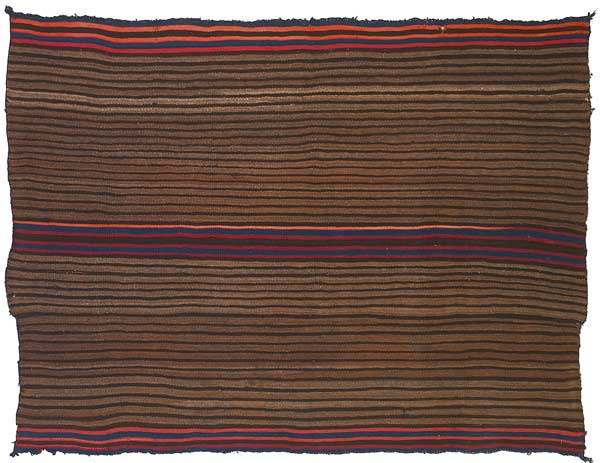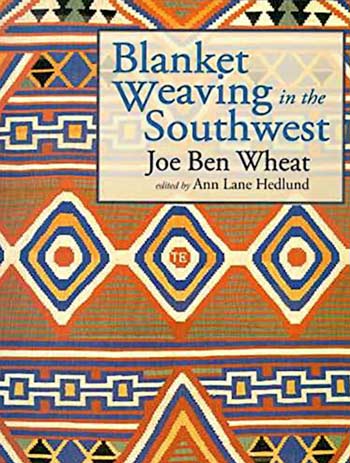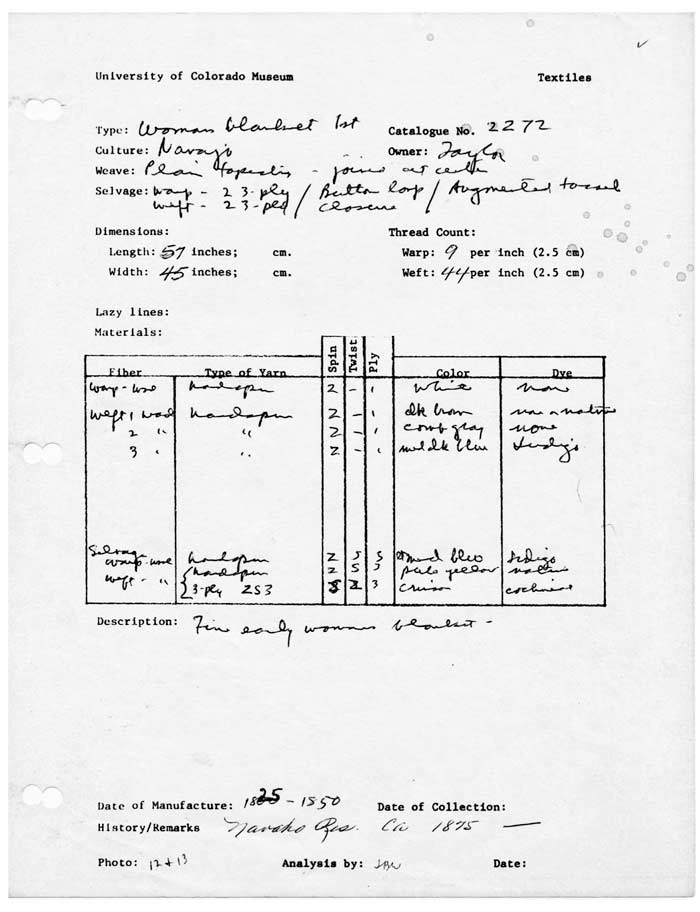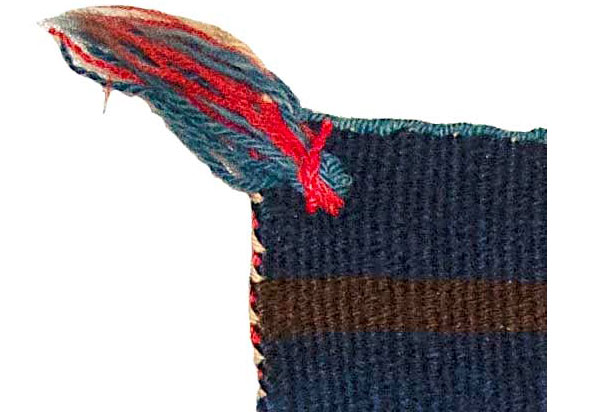#4. A Classic First Phase Chief’s Blanket, Woman’s Style, Navajo, circa 1860, also known as the Taylor First Phase. The first phase measures 45 inches long by 57 inches wide, as woven. The Taylor First Phase’s field of grey and brown stripes above and below its brown central panel qualifies it as a woman’s style first phase. Its four pairs of blue bands and absence of red stripes qualify it as a Ute Style first phase.
The first phase was collected during the 1930s by Alice Bemis Taylor, of Colorado Springs. Taylor was the daughter of Alice Cogswell Bemis and Judson Moss Bemis. Judson Bemis was a philanthropist, and the founder of the J. M. Bemis Company. The Taylor First Phase is in the collection of the Taylor Museum at the Colorado Springs Fine Arts Center, in Colorado Springs, by donation from Alice Bemis Taylor. [Taylor Museum Catalog #2272.]
The Taylor First Phase has no damage, wear, or restorations. It is in 100% original condition. There are two other classic (pre-1865) first phases in museum collections that are in 100% original condition. One is the Harvey First Phase, Ute Style, in the collection of the Nelson-Atkins Museum in Kansas City. The other is the Woodhouse Bayeta First Phase in the collection of the National Museum of the American Indian in Washington, DC. All of the other classic first phases, man’s and woman’s style, in museum collections have damage, wear, restoration, or combinations of the three.
In 2013, the Taylor First phase was exhibited at the Denver Art Museum, as part of Red, White and Bold: Masterworks of Navajo Design, 1840-1870, an exhibition of classic Navajo blankets. Red, White, and Bold was curated by Nancy Blomberg, the Curator of Native Arts at the Denver Art Museum.


Above: The Taylor First Phase, Woman’s Style, Navajo, circa 1860.
The first phase is in the collection of the Taylor Museum at the Colorado Springs
Fine Arts Center, in Colorado Springs, by donation from Alice Bemis Taylor.
Above: The Taylor First Phase, Woman’s Style, Navajo, circa 1860. The first phase is in the collection of the Taylor Museum at the Colorado Springs Fine Arts Center, in Colorado Springs, by donation from Alice Bemis Taylor.
Below: The Fred Harvey First Phase, Ute Style, Navajo, circa 1850.
The first phase is in the collection of the Nelson-Atkins Museum of Art,
Kansas City, by donation from the estate of Fred Harvey.
Below: The Fred Harvey First Phase, Ute Style, Navajo, circa 1850.
The first phase is in the collection of the Nelson-Atkins Museum of Art, Kansas City, by donation from the estate of Fred Harvey.
Classic (pre-1865) chief’s blankets woven in the woman’s style have fields of alternating stripes above and below their brown central panels. Classic chief’s blankets woven in the man’s style have brown and white bands in the fields above and below their brown central panels. Classic woman’s style chief’s blankets measure approximately 45 inches long by 55 inches wide, as woven. Classic man’s style chief’s blankets measure approximately 60 inches long by 72 inches wide, as woven.


Above: The Taylor First Phase, Ute Style, Woman’s Style, Navajo, circa 1860.
Below: The Goodenough Red Line First Phase, Woman’s Style, Navajo, circa 1865.
Ute Style first phases woven in the woman’s style have no red stripes. Bayeta first phases, also known as red line first phases, have thin red stripes.

First phase chief’s blankets in both the man’s and woman’s styles were woven as trade items. While first phases were occasionally worn by members of the Navajo tribe, they never enjoyed the kind of popularity among the Navajo—who did not have chiefs, per se—that they had among high-ranking members of the Blackfoot, Cheyenne, Kiowa, Lakota, Shoshoni, and Ute tribes. The term “chief’s blanket” came into use because the Spanish referred to high-ranking members of the Plains and Prairie tribes as “jefes.” (In Spanish, “jefe” means “boss” or “leader.”) Anglo-Americans referred to jefes as “chiefs.” These were the chiefs who paid premiums for Navajo chief’s blankets, and then either wore the blankets themselves or gave them to their wives and daughters.
While there are classic (pre-1865) woman’s style chief’s blankets with alternating brown and white stripes, the majority of classic woman’s style chief’s blankets, in all phases, have fields of alternating brown and gray stripes.
The difference between the man’s style and the woman’s style raises an interesting question. Man’s style first phases, with their brown and white bands, were identifiable from a distance, especially when the person wearing the man’s style chief’s blanket was on horseback. Woman’s style first phases, with their thin, alternating gray and brown stripes, blended into the landscape and were more difficult to see from a distance. The understated visual profile of the woman’s style first phase may have been a form of protective camouflage, an inconspicuous pattern that made it more difficult for the faraway observer to identify the person wearing the first phase as a woman.
Dr. Joe Ben Wheat and Dr. Ann Lane Hedlund,
co-authors of Blanket Weaving in the Southwest, 2003.
The Taylor First Phase is illustrated as Plate 71 in Blanket Weaving in the Southwest, 2003, by Dr. Joe Ben Wheat and Dr. Anne Lane Hedlund. Wheat and Hedlund describe the first phase as a “Navajo Woman’s Shoulder Blanket (1825-1850), Phase I” and note that it was “Collected on Navajo Reservation, ca.1875.”
Between 1953 and 1988, Dr. Joe Ben Wheat (1916-1997) was Professor of Archaeology at the University of Colorado in Boulder, and First Curator of Anthropology at the University of Colorado Museum of Natural History. Dr. Wheat was the first Professor of Archaeology to attempt a comprehensive survey of the classic (pre-1865) Navajo blankets in American museum collections.
In 1978, Dr. Wheat started working with David Wenger, PhD. Today, Wenger is a specialist in childhood diseases at Jefferson University, in Philadelphia. Wenger and his wife, Joan Wenger, were collectors of classic Navajo blankets. In 1978, Wenger started using a spectrophotometric centrifuge to analyze yarn samples taken from classic and late classic Navajo blankets. Wenger was the first person to apply scientific testing to the yarns and dyes used in Navajo blankets. During the last four decades, Wenger has dye-tested, analyzed, and identified thousands of samples of handspun, raveled, and machine-spun yarns taken from classic and late classic Navajo blankets.
The dye analysis data Wenger got from his centrifuge identified chemical differences between yarn samples dyed with cochineal, yarn samples dyed with lac, yarn samples dyed with combinations of cochineal and lac, yarn samples dyed with indigo, and yarn samples dyed with synthetic dyes. Synthetic dyes were invented and patented in 1857, by the British chemist William Henry Perkin. Synthetic-dyed yarns were in commercial circulation, worldwide, by 1859. Wenger’s dye analyses gave auctioneers, collectors, dealers, and scholars a scientific basis for the circa dating of classic and late classic Navajo blankets. While the absence of synthetic dye in a yarn sample does not prove that a Navajo blanket was woven prior to 1859, the presence of synthetic dye does establish that the blanket from which the yarn sample was taken could not have been woven before 1859.
Dr. Ann Hedlund was Dr. Joe Ben Wheat’s student, protégé, and colleague. After Dr. Wheat’s death, in 1997, Dr. Hedlund gathered all of Dr. Wheat’s notes, papers, transcripts from lectures, and written analyses of classic Navajo blankets. She then re-formatted Dr. Wheat’s scholarly work into Blanket Weaving In The Southwest, which was published in 2003. In 2022, Dr. Hedlund launched the website, JoeBenWheat.org. The site consolidated all of the classic Navajo, Pueblo, and Rio Grande blankets analyzed and classified by Dr. Wheat.


Dr. Joe Ben Wheat’s handwritten analysis of the Taylor First Phase. Dr. Wheat examined the first phase at the Taylor Museum during the late 1970s. In his analysis, Dr. Wheat circa dates the first phase as “1825-1850.” Under History / Remarks, he notes that the first phase was collected on the “Navaho Res. Ca 1875—”. Under Selvage, Dr. Wheat notes that the first phase has “Augmented tassels.”
On Page 220 of Blanket Weaving in the Southwest, Wheat and Hedlund describe Plate 71, the Taylor First Phase, as having “augmented tassels.” However, in person, the Taylor First Phase’s corner tassels, side selvages, and top and bottom edge cords appear to be 100% original to the first phase.

In the Taylor First Phase, the blue yarns used as wefts are handspun Churro fleece dyed in the yarn with indigo. The gray yarns are un-dyed brown and un-dyed white Churro fleeces carded and spun together to create gray handspun yarn. The brown yarns are un-dyed handspun Churro fleece.
The medium blue yarns used in both the first phase’s corner tassels and top and bottom edge cords are two-ply handspun Churro fleece dyed in the yarn with indigo. The red yarns and yellow yarns used in both the first phase’s corner tassels and side selvages are three-ply, machine-spun knitting yarns. Both the red and yellow machine-spun yarns appear to have been dyed in their skeins with synthetic dyes. If the Taylor First Phase’s corner tassels are original, it’s unlikely that the first phase could have been woven before 1860. If the first phase’s corner tassels were replaced, or “augmented,” after 1859, then Dr. Wheat and Dr. Hedlund’s circa date of “1825-1850” may be accurate for the body of the first phase, excluding its side selvages and corner tassels. The first phase’s immaculate condition supports the circa 1860 dating.
After publication of Blanket Weaving In The Southwest, in 2003, our company received many inquiries from art collectors who wanted to buy classic Navajo blankets like the ones illustrated in the book. Of the thirty-three classic and late classic chief’s blankets illustrated in Blanket Weaving In The Southwest, the Taylor First Phase was the most popular. “Can you find us one like this?” was a common question regarding the illustration of the first phase.




